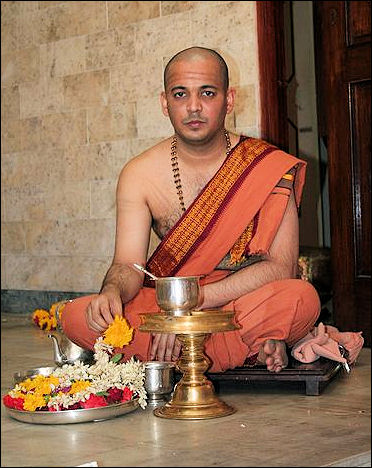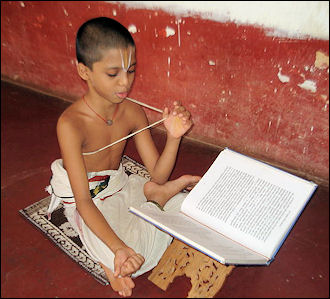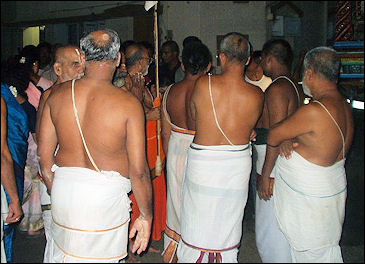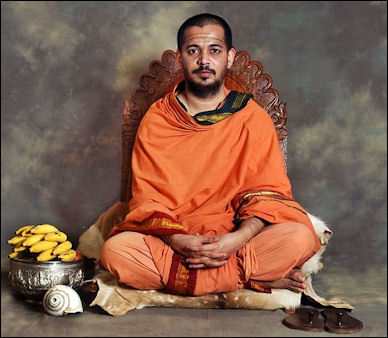HINDU PRIESTS AND BRAHMINS

Brahmin People who acts as officials at temples, conducting or assisting on worship, are known as a “pujari” or priests. Their main duty is to act as intermediaries between the worshipers and god. These priests are supposed to be Brahmins — members of the highest ranking caste group that have traditionally been priests. Brahmin wear the sacred thread. They have traditionally been the final judge of purity and caretakers of temples. Only they could enter the inner sanctuaries of temples and invoke the deities there for a puja.
Technically Hindus are supposed to be assisted by a Brahmin priests when performing rituals or ceremonies, but most simple ceremonies such as making offerings, are done without one. A variety of intermediary priests, holy men and teachers perform and assist with rituals. Brahmin have traditionally have not performed rituals for lower castes anyway. In rural areas local headmen often preside over rituals.
These days priests typically specialize in an area of the religious practice. some are experts in wedding rituals. Others are well-versed in career astrology. Brahmins often serve as priests in temples for higher deities while priests from lower castes serve at temples for lower ranked gods. Many Brahmin either perform their temple duties as a kind of part time job or hobby. Many perform no priestly duties whatsoever. One Brahmin priest at a south Indian temple told the New York Times, "There's no money in it any more. I hope my sons do something else. The income is not enough to live any more.”
Teferi Abate Adem wrote: In Uttar Prodesh the Brahmans, as representatives of the highest caste, served as priests, educators and models of ideal code of conduct. The latter included living on a strictly vegetarian diet and avoiding alcohol and tobacco. In Senapur, every Hindu family of caste, especially among the land owning Thakurs, required the religious services of two kinds of Brahman. One was the guru or family preceptor who came at least once a year, and other times as required, to give advice on intimate family affairs, to look into horoscopes of family members, to tell inspiring religious stories and to read from holy scriptures. The second was the purohit or priest who officiated at ceremonies such as childbirth, construction of new homes, initiation rituals, and marriage processions. Brahman priests however did not extend their services to the eight lowest castes in the hierarchy whose work or food habits are believed to be polluting. For their religious needs, lower caste members mostly depended on shamans (ojha). [Source: Teferi Abate Adem, e Human Relations Area Files (eHRAF) World Cultures, Yale University]
Websites and Resources on Hinduism: Hinduism Today hinduismtoday.com ; India Divine indiadivine.org ; Wikipedia article Wikipedia ; Oxford center of Hindu Studies ochs.org.uk ; Hindu Website hinduwebsite.com/hinduindex ; Hindu Gallery hindugallery.com ; Encyclopædia Britannica Online article britannica.com ; International Encyclopedia of Philosophy iep.utm.edu/hindu ; The Hindu Religion, Swami Vivekananda (1894), .wikisource.org ; Journal of Hindu Studies, Oxford University Press academic.oup.com/jhs
Brahmins and Purity
Members of the highest priestly castes, the Brahmins, are generally vegetarians (although some Bengali and Maharashtrian Brahmins eat fish) and avoid eating meat, the product of violence and death. High-ranking Warrior castes (Kshatriyas), however, typically consume nonvegetarian diets, considered appropriate for their traditions of valor and physical strength.[Source: Library of Congress, 1995 *]
A Brahmin born of proper Brahmin parents retains his inherent purity if he bathes and dresses himself properly, adheres to a vegetarian diet, eats meals prepared only by persons of appropriate rank, and keeps his person away from the bodily exuviae of others (except for necessary contact with the secretions of family infants and small children).*
If a Brahmin happens to come into bodily contact with a polluting substance, he can remove this pollution by bathing and changing his clothing. However, if he were to eat meat or commit other transgressions of the rigid dietary codes of his particular caste, he would be considered more deeply polluted and would have to undergo various purifying rites and payment of fines imposed by his caste council in order to restore his inherent purity.*
Lower Castes and Pollution

lower caste snake charmer
In sharp contrast to the purity of a Brahmin, a Sweeper born of Sweeper parents is considered to be born inherently polluted. The touch of his body is polluting to those higher on the caste hierarchy than he, and they will shrink from his touch, whether or not he has bathed recently. Sweepers are associated with the traditional occupation of cleaning human feces from latrines and sweeping public lanes of all kinds of dirt. Traditionally, Sweepers remove these polluting materials in baskets carried atop the head and dumped out in a garbage pile at the edge of the village or neighborhood. The involvement of Sweepers with such filth accords with their low-status position at the bottom of the Hindu caste hierarchy, even as their services allow high-status people, such as Brahmins, to maintain their ritual purity. [Source: Library of Congress, 1995 *]
Members of the Leatherworker (Chamar) caste are ascribed a very low status consonant with their association with the caste occupation of skinning dead animals and tanning the leather. Butchers (Khatiks, in Hindi), who kill and cut up the bodies of animals, also rank low on the caste hierarchy because of their association with violence and death.*
However, castes associated with ruling and warfare — and the killing and deaths of human beings — are typically accorded high rank on the caste hierarchy. In these instances, political power and wealth outrank association with violence as the key determinant of caste rank.*
Brahmins
Brahmins are the highest ranking caste group and are the top of the varna system above Kshatriyas, Vaisyas and Sudras. Brahmins have traditionally been priests, either in temples or to particular families and have traditionally been better educated, held high positions and had land and money. Many have worked as teachers, scribes, landowners and government clerks. Today they are employed in a number of professions. Many fulfill their priestly duties only a part time basis.

Brahmin Ikshitar
Brahmins are expected to maintain a high level of purity, be literate in Sanskrit and other languages, and possess knowledge of Hindu liturgy. They eschew menial labor and often have very soft hands to prove it. They do not eat ginger, onions of potatoes because they grow in the unclean ground. In caste terms they consider themselves superior to Mahatma Gandhi who was Vaisya.
In terms of caste the poorest and most lowly Brahmins have traditionally looked upon themselves as superior to kings, who belong to the Kshatriya caste of warriors and nobles, which is lower than the Brahmin caste. Early in Aryan history the Brahmins gained political and religious superiority over the Kshatriyas. Brahmins maintained their power over the centuries by being the only caste allowed to learn the sacred language of Sanskrit.
Brahmins and other members of high castes are now referred to as Forwards. With the introduction of quotas to give members of lower caste more power and access to education and to public service jobs, many Brahmins are leaving India and seeking their fortune elsewhere. One Brahmin man told U.S. News and World Report, "There is an unwritten rule for Brahmins in Tamil Nadu: Get out as so you can — and stay out."
Brahmins often live together is separate neighborhood. They began their day with a trip to the family prayer room, dab vermillion powder on their brow, light an incense stick or oil lamp and chant Sanskrit verses to a portrait of a Hindu deity such as Surya, the sun god.
Brahmin Priests and Women
Among Brahmins only men are allowed to serve as priest; women are often responsible for the daily pujas. Brahmin women are expected to bathe their husband's feet each morning as a sign of respect.
Brahmins may act as family priests for upper castes but not lower ones. They can officiate at shrines and temples and at rituals associated with major festivals. They conduct all the rituals performed at a marriage, are present at important religious occasions and read excerpts from the vedas and other sacred Sanskrit texts and recite from the Puranas and the Ramayana and Mahabharata. Brahmins are sometimes paid for their services with cows rather than money.
See Priests, Religion
Brahmin Customs

Brahmin student learning the Vedas Brahmin are expected to maintain a higher standard of purity and obey an elaborate set of taboos, which including vegetarianism (which sometimes means going without cheese, eggs or milk). Some Brahmins have long beards and shoulder-length hair. Brahmin priests are required to wash their rice in running water before eating. Priests in some places have been known to chose to die rather than eat unwashed rices. Describing a Brahmin he met, Theroux wrote, "He neither drank nor smoked...He got up at five every morning, had an apple, a glass of milk, and some almonds, he washed and said his prayers, and then he took a walk. Then he went to his office...He furnished his office sparsely."
Many Brahmins have traditionally lived off earnings from their land and occasionally presided over events and temple rituals. A large amount of their time has been spent learning and reciting Sanskrit slokas. Brahmins have also served as scholars and teachers of the Vedas and participated in sacrifices, individual worship rituals and provided training and certification for lower-caste priests. Some large sacrifices take ten days to carry out and months to prepare.
Among the Nambudiri Brahmin in Kerala only the oldest son has traditionally been allowed to marry. Sometimes marriages are arranged at birth to stay within the confines of caste rules. Sometimes The oldest son took take as many as three wives. Dowries for girls were quite high and sometimes fathers took a second wife to save on the dowry for his daughter. Younger sons either remained celibate or formed semipermanent liaisons with somewhat lower matrilineal castes.
Many business and political leaders are Brahmins. Nearly all five-star hotels and top restaurants assign upper Brahmins to attend to their rich clients. When Daimler Benz began operating in India, the company found that it needed to hire Brahmins to deal with their upper class clients.
Brahmin have traditionally been very education minded. Brahmin mothers have been expected to stay home and tutor their children
Sacred Thread

Brahmin_threads The sacred thread) is a symbol of highs status in the caste system: only the Brahmin and Kshatriya castes are allowed to wear it. It is comprised of three cotton threads that are looped over the shoulders across the chest and under the opposite arm. It signifies that the wearer is twice born: the first time by his mother and the second time when he is initiated into Hinduism and receives the sacred thread (which is known by many names, varying by region and community, including “janai, janeu, lagun, yajnopavita, yagyopavit, yonya” and “zunnar”).
The three intertwined threads symbolize the mind, body and act of speaking The knots tied in three threads symbolize the mastery of these three things by the wearer. The wearer is expected to keep the sacred thread clean and pollution free. If it becomes frayed, dirty or polluted by contact with lower castes or menstruating women it must be replaced. The wearer goes through great lengths — often tucking it behind his ear, to make sure it doesn’t get dirty when he goes to the bathroom, shaves or washes.
The sacred thread ceremony serves as a coming of age ceremony for the castes that wear it. Traditionally, at age seven years of age a boy’s head is shaved or his hair is cut, his body is throughly cleaned and his fingernails and toe nails are cut. If the head is shaved usually a small tuft of hair is left to show the boy is a Hindu. Before the ceremony the boy eats only one meal that can not contain meat, onions or garlic. At the ceremony which can be held at a home or a temples a Brahmin priest reads scriptures, invokes Vishnu and drapes the sacred thread over the initiates neck.
After being given the sacred thread the boy is fully initiated into his caste and is regarded as a man. He is allowed to eat with the men and is given new responsibilities. The cost of staging the ceremony can be quite high. Some times several poorer families join together to reduce costs.
School For Boys Becoming Priests
Reporting from New Delhi, Rama Lakshmi wrote in Washington Post: “Hidden in a tightly packed neighborhood of middle-class condominiums, cheap Chinese restaurants and garment sweatshops is a thriving 3,500-year-old Hindu tradition. It is a residential school that teaches young boys the art of chanting Hindu verses in classical Sanskrit and trains them to become Hindu priests. For eight years, they study religious rituals without material distractions. [Source: Rama Lakshmi, Washington Post, October 18, 2007 -]

students studying at a Vedic school
“Sriram Sharma, a thin 13-year-old with large eyes and a shy smile, has lived at the school for more than two years, memorizing and reciting the hymns from the Hindu religion's oldest texts, called the Vedas. After six more years of training at the School of Vedas, he will become a Hindu priest who can perform prayer rituals involving fire worship and rhythmic incantations. He also studies math, English and Hindi for an hour each day. -\
"The Vedas contain the sacred knowledge of Hindu religion and were passed down orally by sages," Sriram says, standing in front of a mirror hung on a fading pink wall. He wears a white wraparound but is bare-chested and barefoot. In his palm, he grinds fragrant sandalwood, with which he cautiously draws a long U-shape on his forehead in a sign of devotion. "I have to get the shape right. It is an important tradition," he explains as he drags his thumb up his forehead. Then he takes red vermilion powder and stamps a dot between his brows. -\
White threads hang diagonally from his bare shoulder like a sash, and a tiny tuft of hair is knotted at the back of his shaved head. Sriram is part of the old, unbroken chanting tradition that UNESCO, in 2003, proclaimed a masterpiece of "the oral and intangible heritage of humanity." "Learning the Vedas is hard," Sriram says, massaging his tuft with coconut oil before sitting down to chant the first prayer of the day, around 6:30 a.m. "At first, the school felt like a jail. I missed my mother and cried for weeks, but now this is home." -\
“The older boys say they are eager to start their work in the real world and earn the social status that comes with knowledge of the Vedas. Hari Ramachandran says his father was a personal driver for a family and did not want his son to end up doing something similar. "Even doctors and engineers respect priests who know the Vedas," says Hari, 16. "They would speak to us humbly. If I was a driver, they would bark at me and say, 'Go, get the car out of the garage quickly.' "” -\
Life at School For Boys Becoming Priests
Describing the daily routine of the boys at the New Delhi school for priests, Rama Lakshmi wrote in the Washington Post, “The day begins for these 27 boys at 4:45 a.m., when the lights are switched on in the basement, where they sleep on jute floor mats. When a supervisor calls out, they uncurl lazily under the sheets and stretch. Some go back to sleep, while others stare at the floor vacantly for a few minutes.” Sriram “folds his sheet and mat and stacks them on the open stone shelf on the wall. He then steps tentatively into the cold shower and comes out shivering and chanting under his breath. [Source: Rama Lakshmi, Washington Post, October 18, 2007 -]

student at a Vedic school
“Soon the hall resounds with chanting, loud enough to wake the neighborhood. The boys cannot understand what they chant because the meaning of the hymns will be taught only after eight years of memorizing the procedures of Hindu rituals. A little boy sitting next to Sriram is having a bad start. He is seized by a bout of hiccups during the chanting but refuses to take a break.-\
“The boys follow a grueling routine of do's and don'ts — they cook and eat only vegetarian food, wash their own clothes by hand, cannot call or visit their families, cannot take medicine except for a physical injury, and cannot watch television. Parents cannot bring any gifts. The teacher, a bearded middle-age man who set up the school 11 years ago, walks in to inspect their performance. He pauses in front of each boy, listens carefully and nods. "The boys are not allowed to go out. I keep them away from the world of illusions and desires. They lead pure, austere lives," says G.K. Sitaraman, respectfully called "Guru ji." "This school runs in an orthodox way, like thousands of years ago. The only difference is that we are no longer in the jungles." -\
“Each class begins with the students prostrate on the floor before the teacher. Sitaraman turns to the boys and says: "The knowledge of the Vedas is the only education that cannot be erased. Everything else is impermanent in this world." But the mood is not always somber; the boys have fun even while chanting the divine revelations. They give one another sidelong looks, sharing an unspoken joke about a plump student who is washing a black stone idol of a Hindu deity in milk. "We call him 'Tummy' because he is fat," Sriram explains between chanting sessions. "Every boy has a nickname here — 'Snake,' 'Mouse,' 'Chili,' 'Bucktooth.' I am 'All-India Radio.' They say I talk nonstop." -\
“Shortly before 11, as the boys gather around a ceremonial wood fire and dot their chests with ash, they speak in conspiratorial whispers. The topic is their daily game of cricket. "Did you hear that they will not let us play cricket in the park anymore?" says Kedarnath Dave, 12. "It is basement cricket for us from now on. The people living in the apartments do not want us mixing with their children anymore." -\
Indian Shrine Workers Allowed to Wear Underwear

Brahmin priest A shrine in Thiruvananthapuram in Kerala used to require workers to wear only a dhoti, without underwear while performing certain duties until human rights activists and local authorities intervened, Reuters reported: Employees counting donations at a popular Hindu shrine in southern India will no longer have to take off their underpants at work after the local human rights commission intervened. Police and temple authorities imposed the dress code at the Sabarimala hill shrine in Kerala five years ago after thefts were reported from the shrine's strongroom. Employees in the vault, all of whom were men, were made to work topless wearing only a dhoti — a cotton wrap worn around the waist — with nothing underneath. [Source: Reuters, May 23, 2008 ^|^]
“But they found it degrading, and their union complained to the Kerala State Human Rights Commission. "The employees on duty are made to strip before an officer before leaving the office to ensure that they do not carry anything in their underwear," said Chavara Gopakumar, the union leader. "It is humiliating and an insult to human dignity." The state's human rights commission agreed. ^|^
“Authorities at the shrine, which is dedicated to Ayyappa, a south Indian deity, said on Friday they would end the practice and have begun looking into electronic surveillance systems. Thousands of pilgrims flock to the shrine between November and January, bringing cash, precious metals and jewels in offerings. They are expected to forego meat, alcohol and sex for 41 days before arriving. Women of child-bearing age are forbidden.” ^|^
Text Sources: “World Religions” edited by Geoffrey Parrinder (Facts on File Publications, New York); “Encyclopedia of the World’s Religions” edited by R.C. Zaehner (Barnes & Noble Books, 1959); “Encyclopedia of the World Cultures: Volume 3 South Asia “ edited by David Levinson (G.K. Hall & Company, New York, 1994); Wikipedia, BBC, National Geographic, the New York Times, Washington Post, Los Angeles Times, Smithsonian magazine, The New Yorker, Reuters, AP, AFP, Lonely Planet Guides, Compton’s Encyclopedia and various books and other publications.
Last updated March 2024
